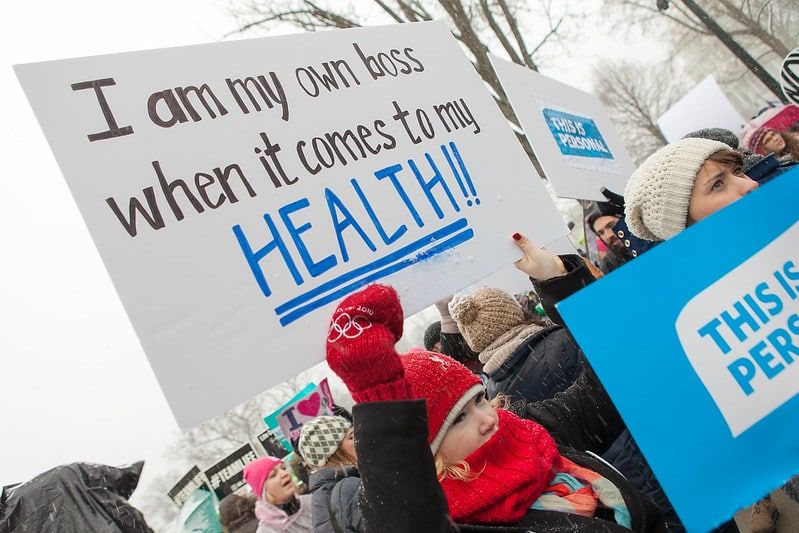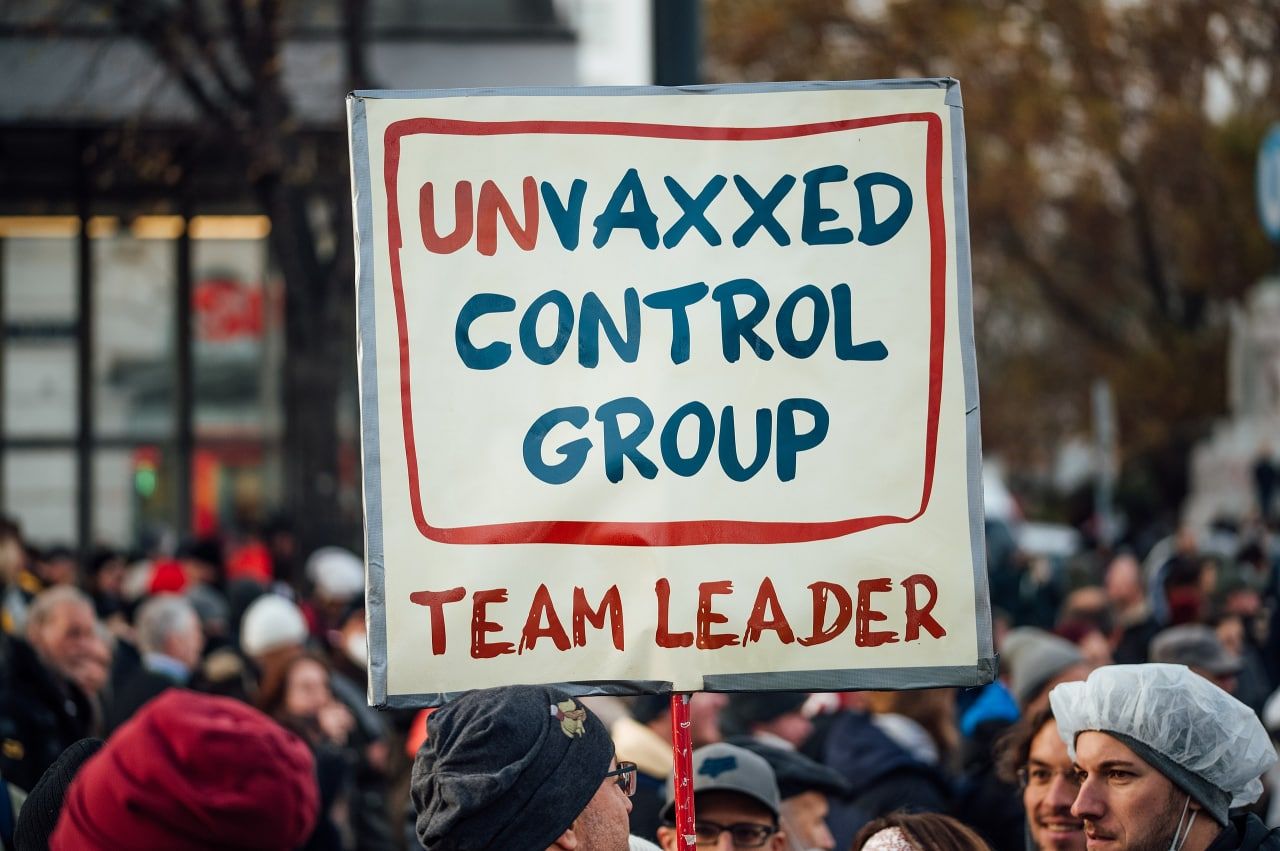
The Subtle Psychology of ‘Nudging’ During a Pandemic
March 21, 2022 by Bryony Lau
In the early 1990s, the renovations manager at Amsterdam’s Schiphol Airport decided to decorate each bathroom urinal with a realistic image of a fly, placed just above the drain. For decades, urinal designers had sought a way to curb the unpleasant spillage around urinals, and it turned out that by giving men something to aim at — in this case, a humble insect — spillage dramatically reduced. This airport innovation went on to become one of the most well-known examples of a nudge: a subtle prompt that can alter human behavior. The formal concept of nudging was first popularized by economist Richard H. Thaler and legal scholar Cass R. Sunstein, who co-authored the best-selling 2008 book “Nudge: Improving Decisions About Health, Wealth, and Happiness.” The book defines a nudge as something that “alters people’s behavior in a predictable way without forbidding any options or significantly changing their economic incentives.” The authors framed nudging as a bipartisan technocratic fix that could solve tricky policy problems while preserving individual freedom. Governments didn’t need to tell people what to do; they needed to nudge them. Following the book’s publication, nudges were embraced by both the U.S. and U.K. governments, and Thaler went on to win the Nobel Prize in economics. But two years after Covid-19 was first detected in Wuhan, China, nudges have lost some of their luster. To curb the spread of the novel coronavirus, governments and businesses have resorted to harsher measures, such as lockdowns and vaccine mandates, which nudges were purported to help policymakers avoid. For skeptics, a reassessment of nudges was overdue. We shouldn’t “fool ourselves into thinking that nudges are going to magically fix our larger systemic issues,” said Neil Lewis, Jr., a behavioral scientist and assistant professor at Cornell University. “They're not.” Nudging draws on insights from psychology, primarily the work of Daniel Kahneman, who won the Nobel Prize in economics in 2002, and Amos Tversky. These two Israeli psychologists pioneered the study of mental shortcuts that humans rely on to make decisions, known as heuristics. They presented initial findings in a 1974 paper, “Judgment under Uncertainty: Heuristics and Biases.” Their work had clear implications for economics, which assumes that people make rational decisions in pursuit of their interests. Kahneman and Tversky showed that that isn’t how the human mind usually works. Beginning in the late 1970s, Thaler partnered with Kahneman and Tversky to apply their findings to his field, creating behavioral economics. In "Nudge," Sunstein and Thaler brought behavioral science to the masses, with intuitive and simple examples, such as placing carrot sticks at eye level in school cafeterias to encourage healthier eating. Governments quickly caught on. Sunstein went to Washington, D.C., to work for the White House in 2009. Six years later, then-President Barack Obama issued an executive order to encourage the use of behavioral science in federal policymaking. In 2010, the U.K. Prime Minister set up the Behavioral Insights Team within the government’s Cabinet Office; the team was spun off as a private company in 2014 and now has offices around the world. Globally, there are now more than 200 teams, or nudge units, that specialize in applying behavioral science to everyday life. Nudge units had important successes. In the U.K., the Behavioral Insights Team sent letters to clinics whose family doctors were overprescribing antibiotics. The effort yielded a 3 percent decrease in prescriptions. Another initiative demonstrated the power of tweaking a message: Taxpayers who paid their income tax late received letters telling them they were in a minority, as nine out of 10 people pay on time. That gentle admonition appears to have resulted in an additional 120,000 people paying about $6.5 million into U.K. government coffers. And behavioral science notched another win when governments and companies made enrollment in retirement savings plans a default option, helping people save more. But as with any trend, there are skeptics. Some commentators decry nudges as government overreach or as an infringement on individual autonomy. But there are also people who say the opposite: that nudges result in governments’ not doing enough. In 2011, the U.K. House of Lords issued a report that questioned why nudges were being favored over more traditional policy tools, like regulation. In theory, behavioral science doesn’t skew left or right, but in the hands of politicians dubious of “big government” nudges can become a way to sidestep more muscular interventions. Behavioral science had a rough start during the pandemic. When Boris Johnson decided not to impose a U.K. lockdown in March 2020, rumors swirled that the head of the Behavioral Insights Team, David Halpern, was advising against stricter measures. Hundreds of behavioral scientists then signed an open letter demanding the government explain the evidence supporting its decision. A subsequent inquiry by the Parliament found that senior officials had opted initially for softer measures assuming, incorrectly, that the public wouldn’t comply with a lockdown. The pandemic revived a debate that has swirled around behavioral science for the past decade: What can nudges achieve? And what can they not? As Covid-19 infections grew exponentially in 2020, behavioral scientists wanted to help. Nudges presented a possible route to controlling the virus, particularly in the absence of vaccines and evidence-based treatments, said Jay Van Bavel, an associate professor of psychology at New York University. That April, Van Bavel and 41 other researchers — among them, Sunstein — published a paper that outlined how the social and behavioral sciences could contribute, from boosting trust in government policies to fighting conspiracy theories. The authors were circumspect, though; the findings they summarized were “far from settled” and pre-dated the Covid-19 crisis. Research on the social dimensions of the pandemic soon began in earnest. The National Science Foundation launched a rapid response program, which could provide up to $200,000 per grant. According to Arthur Lupia, who recently completed his term as leader of the Directorate for Social, Behavioral, and Economic Sciences, the directorate processed the same number of grants over a six-week period that spring as it normally does in six months. The nonprofit Social Science Research Council also put out a call for proposals and was overwhelmed by the response: Out of 1,300 applications, they could only fund 62. As scientists learned more about how the coronavirus spread through the air, the science in support of social distancing and masks became clearer. Governments knew what they wanted their citizens to do, but they still had to think carefully about how to encourage people to change their behavior. That’s where nudges could help. Researchers didn’t know if nudges would work under the extreme conditions of a pandemic. “Nudges are usually tested for the routine tasks most citizens undertake, such as submitting a tax return, not in crisis situations when both the environment and people’s choices are anything but routine,” wrote four academics who ran a survey on people’s intentions to adhere to the U.K.’s first stay-at-home order. The paper looked at whether public health messages could nudge behavior. Were people more likely to comply if they were told everyone else was abiding by the rules? Or was it better to stress how social distancing would benefit someone specific, like grandparents? The results were discouraging: Behavior change only occurred when people were asked to take an extra step of writing about how they intended to reduce the spread while reflecting on someone more likely to be vulnerable or to be exposed to the virus. But the impact faded within two weeks. A similar experiment in Italy, conducted in mid-March and published on the preprint server medRxiv, showed that such nudges mattered little because most people already knew what they needed to do and were following orders. More information, however formulated, didn’t matter. Other early studies that used surveys to measure the impact of public health messaging in Western countries similarly showed mixed results. Even so, there were findings that were more encouraging, such as an experiment in West Bengal that used video clips of Nobel laureate Abhijit Banerjee explaining Covid-19 public health guidance; researchers found reporting of symptoms to community health workers doubled among those who watched the videos. A similar survey-based study among low-income Americans showed that video messages from physicians increased knowledge of Covid-19 and encouraged people to seek more information. But Lupia of the NSF, which funded the studies, interpreted the findings cautiously. “Do we know if they generalize?” he asked, reflecting on whether the videos, or something similar to them, would have been so effective elsewhere. “I'm not sure.” Not everyone jumped into Covid-19 research. Lewis, the behavioral scientist at Cornell, was nervous about the sudden pivot. In September 2020, he wrote an article in FiveThirtyEight pointing out that in fewer than seven months, 541 studies on Covid-19 had been released as preprints — a version of a paper that has yet to be peer reviewed — on PsyArXiv, the main repository for preprints in psychology. A lot of that research wasn’t ready to be applied to real-world settings, said Lewis. In October 2020, he and other likeminded psychologists expressed their misgivings in a paper titled "Use Caution When Applying Behavioral Science to Policy.” Sibyl Anthierens, a sociologist and co-lead of the social science studies team of the European Union-funded Covid-19 research initiative RECOVER, said that pandemic researchers were able to produce studies that offered a “rich description of a particular situation,” such as how some families prevented infections from spreading within the household. But applying such findings to an ever-evolving pandemic proved tricky. Sometimes, by the time a study was finished, “the context might have already been changed completely,” she said. For example, studies done on handwashing in the first wave were no longer as relevant by the second, as the focus shifted to mask-wearing. Tailoring research to context was crucial, but difficult. The pandemic also magnified a weakness of nudges: The effects captured by researchers could be lost when a nudge was scaled up and used to influence behavior beyond the confines of a laboratory. One meta-study, which was based on 126 randomized controlled trials — long considered the gold standard of scientific evidence — showed that where academic studies had influenced behavior on average 8.7 percent of the time, nudge units only had an impact of 1.4 percent. As research ramped up during Covid-19, the gap between what experts thought they knew about nudges and how they function in practice widened. As Varun Gauri, a senior nonresident fellow at the Brookings Institution and former head of the World Bank’s behavioral science unit, said, the pandemic “left behavioral scientists and others kind of scratching our heads saying, what do we do?” Once vaccines began rolling out in 2021, behavioral scientists turned to getting shots in arms. Dena Gromet, executive director of the Behavior Change for Good Initiative at the University of Pennsylvania, had co-authored a study that showed sending texts to more than 47,000 patients before their primary care visit increased flu vaccinations by 5 percent in fall 2020. The same tactic might work with the Covid-19 vaccine, she hypothesized, and, initially, it did. A study from California in the winter of 2021 used text messages to boost appointments by 6 percent and actual vaccinations by 3.6 percent. As winter turned to spring and summer, though, vaccinations lagged. Policymakers began offering incentives. In May, Ohio announced its “Vax-a-Million” lottery: Ohioans who were vaccinated could win up to $1 million in a weekly draw that would be held over five weeks. Several other states launched similar initiatives. Gromet was cautiously optimistic. Lotteries had successfully changed behavior before, such as by motivating adults to exercise. Other experts also thought that the chances were good. “If you need something quick and off the shelf during a crisis, I would have thought the lotteries would have been it,” said Gauri, noting that lotteries are relatively easy to implement. Gromet and her colleagues approached Philadelphia’s officials with a proposal: They would run three sweepstakes of $50,000 each to test the impact of a lottery on vaccination rates. There was a modest increase of 11 percent in the first draw, but overall the lottery had had little effect. (The results were published on the preprint server SSRN.) That’s why governments need to test nudges and incentives before investing their limited resources, said Gromet: “Different approaches are going to work for different people and at different times.” Nudging works if people are already inclined to do the thing they are being reminded to do, she points out, which is why tactics that worked earlier in the vaccination campaign no longer did. Governments and businesses were increasingly dealing with vaccine holdouts who couldn’t be nudged or offered incentives. Instead, mandates caught on, with major companies like United Airlines requiring employees to get vaccinated to come to work. No one knows if governments will continue to use heavier-handed interventions for public health, but in an August op-ed, Thaler himself suggested that it was time to do more than merely nudge those not yet vaccinated against Covid-19. Instead, he suggested sterner measures like vaccine passports and different isolation policies for vaccinated versus unvaccinated people, as adopted by the NFL. We might call these interventions, he wrote, “pushes and shoves.” Bryony Lau is a freelance writer and researcher from Canada. This article was originally published on Undark. Read the original article.
If you liked what you just read and want more of Our Brew, subscribe to get notified. Just enter your email below.





Related Posts
Pope Leo Xiv is the First Member of the Order of St. Augustine to Be Elected Pope – but Who Are the Augustinians?
Jun 04, 2025
People Say They Prefer Stories Written by Humans Over AI-generated Works, Yet New Study Suggests That’s Not Quite True
Apr 02, 2025
What are AI Hallucinations? Why AIs Sometimes Make Things Up
Mar 25, 2025